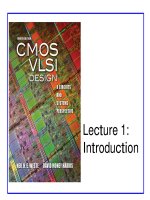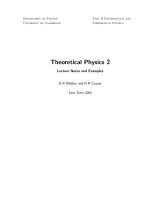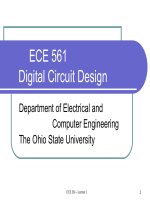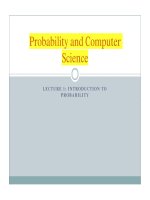- Trang chủ >>
- Khoa Học Tự Nhiên >>
- Vật lý
General physics 2 electricity magnetism lecture 1
Bạn đang xem bản rút gọn của tài liệu. Xem và tải ngay bản đầy đủ của tài liệu tại đây (542.41 KB, 38 trang )
Ngac An Bang, Faculty of Physics, HUS
GENERAL PHYSICS 2
Electricity & Magnetism
1
Physics 2
Ngac An Bang, Faculty of Physics, HUS
Text book:
Fundamentals of Physics, David Halliday et al., 8th Edition.
Physics for Scientists and Engineers, Raymond A. Serway and John W.
Jewett, 6th Edition.
Instructor: Dr. Ngac An Bang
Faculty of Physics, Hanoi University of Science
Homework: will be assigned and may be collected.
Quizzes and Exams:
There will be at least two (02) 15-minute quizzes.
There will be a mid-term exam and a final exam.
Grading policy:
Homework and Quizzes: 20 %
Midterm exam: 20 %
Final exam: 60 %
2
Physics 2
Ngac An Bang, Faculty of Physics, HUS
Lecture 1
Electric Charge and Field
Electric Charges
Coulomb’s Law
Electric Fields
Electric Field of a Continuous Charge Distribution
Motion of Charged Particles in a Uniform Electric Field
3
Electric Charge and Field
Ngac An Bang, Faculty of Physics, HUS
Mother and daughter are
both enjoying the effects of
electrically charging their
bodies. Each individual hair
on their heads becomes
charged and exerts a
repulsive force on the other
hairs, resulting in the
“stand-up’’ hairdos that you
see here. (Courtesy of
Resonance
Research
Corporation)
4
Electric Charge and Field
Electric Charge
Electric charge
Ngac An Bang, Faculty of Physics, HUS
Some simple experiments demonstrate the existence of
electric forces and charges
There are two types of charge. Convention dictates sign of charge:
Positive charge
Negative charge
Like charges repel, and opposite charges attract.
5
Electric Charge and Field
Electric Charge
Ngac An Bang, Faculty of Physics, HUS
Quantization of Charge
Charge is quantised
The smallest unit of “free” charge known in nature is the charge
of an electron or proton, which has a magnitude of
e = 1.602 x 10-19 C
Charge of any ordinary matter is quantized in integral multiples
of the elementary charge e, Q = ± Ne.
An electron carries one unit of negative charge, -e,
While a proton carries one unit of positive charge, +e.
Note that although quarks (u, d, c, s, t, b) have smaller charge in
comparison to electron or proton, they are not free particles.
6
Electric Charge and Field
Electric Charge
Charge conservation
Ngac An Bang, Faculty of Physics, HUS
A universal conservation law
• In a closed system, the total amount of charge is conserved since charge
can neither be created nor destroyed.
• A charge can, however, be transferred from one body to another.
• The β- reaction
n → p + e + νe
0e = 1e -1e + 0e
n(udd), p(uud)
d → u + e + νe
• Electron-positron annihilation
e- + e+ → γ + γ
• Pair production (γ-conversion)
γ → e- + e+
7
Electric Charge and Field
Electric Charge
Ngac An Bang, Faculty of Physics, HUS
Some basic concepts
All materials acquire an electric charge
Neutral object: Total positive charge Q+= Total negative charge Q-.
Positively charged object: Q+ > Q-,
Negatively charged object: Q+ < Q In this part, we consider only two types of materials
• Conductors: Electrical conductors are materials in which some of the electrons
are free electrons that are not bound to atoms and can move relatively freely through
the material;
• Insulators: are materials in which electrons are bound to atoms and can not move
freely through the material.
8
Electric Charge and Field
Charge Manipulation
Ngac An Bang, Faculty of Physics, HUS
Charge transfer by contact
Charging Objects By Induction
9
Electric Charge and Field
Coulomb’s Law
Ngac An Bang, Faculty of Physics, HUS
Coulomb’s Law
Consider a system of two point charges, q1 and q2, separated by a distance r in
vacuum.
The force F12 exerted by q1 on q2 is given by Coulomb's law
q1q 2
q1q 2 r
F12 k 2 r k 2
r
r r
The force F21 exerted by q2 on q1 is given by
F21 F12
The Coulomb constant k in SI units has the value
2
1
9 Nm
k
8 .9875 10
4 0
C2
The constant ε0 is known as the permittivity of free space and has the value
0 8.854 2 10
-12
C2
Nm 2
10
Electric Charge and Field
Coulomb’s Law
Ngac An Bang, Faculty of Physics, HUS
Electric force
The electric force between charges q1and q2 is
(a) repulsive if charges have same signs
(b) attractive if charges have opposite signs
The electric force is a radial force, thus, a conservative force.
More than one force, Superposition principle is applied.
11
Electric Charge and Field
Coulomb’s Law
Ngac An Bang, Faculty of Physics, HUS
Example 1
The electron and proton of a hydrogen atom are separated (on the average) by a
distance of approximately 5.3 x10-11 m. Find and compare the magnitudes of the
electric force and the gravitational force between the two particles.
• From Coulomb’s law, we find that the magnitude of the electric force is
2
19
2
e2
Nm
(
1
.
6
10
C
)
8
FE k 2 8 .8975 10 9
8
.
2
10
N
2
11
2
r
C (5 .3 10 m )
• Using Newton’s law of universal gravitation we find that the magnitude of the
gravitational force is
2
me m p
(9 .1 10 31 kg )(1 .67 10 27 kg )
11 Nm
47
FG G
6
.
67
10
3
.
6
10
N
2
2
11
2
r
kg
(5 .3 10 m )
• The ratio of them is
F
E
FG
2 10 39
Questions
1.
2.
Does the ratio γ depend on the distance r between the electron and the proton?.
12
What is the fundamental difference between the two forces?.
Electric Charge and Field
Coulomb’s Law
Ngac An Bang, Faculty of Physics, HUS
Example 2
Find the force on the charge q3 assuming that
q1 = -q2 = 6.0 μC, q3 = 3.0 μC, a = 2.0 x10-2 m
The total force F3 acting
q3 is
on the charge
F3 F13 F23
The electric force F13 can be calculated as
F13
1 q1q 3 r13
1 q1q 3
rˆ13
4 0 r132 r13 4 0 r132
F13
1 q1q 3
1 q1q 3 2
cos .i sin . j
i j
4 0 2 a 2
4 0 a 2 4
The electric force F23 can be calculated as
F23
Finally,
1 q 2 q 3 r23
1 q 2 q3
1 q1 q 3
rˆ23
i
4 0 r232 r23 4 0 r232
4 0 a 2
F3 F13 F23
1 q1q 3
4 0 a 2
2
2
1i
4
4
j
13
Electric Charge and Field
Coulomb’s Law
Ngac An Bang, Faculty of Physics, HUS
Example 2
Find the force on the charge q3 assuming that
q1 = -q2 = 6.0 μC, q3 = 3.0 μC, a = 2.0 x10-2 m
The total force F3 acting on the charge q3 is
1 q1q 3 2
1 i
2
4 0 a 4
The magnitude F3 is
2
2
1 q1q 3 2
F3
1
2
4 0 a 4
4
Angle ϕ can be calculated as
F3 F13 F23
tan
F3 y
F3 x
2
4
2
j
1/ 2
3 .0 N
2 /4
2
4 1
151 .3 0
14
Electric Charge and Field
Electric Field
Ngac An Bang, Faculty of Physics, HUS
Defining the electric field
What is the mechanism by which one particle can exert a force on another
across the empty space between particles?
Suppose a charge is suddenly moved. Does the force exerted on a second
particle some distance r away change instantaneously?
A charge produces an electric field everywhere in space.
The force is exerted by the field at the position of the second charge.
The field propagates through space at the speed of light.
It’s a vector field.
15
Electric Charge and Field
Electric Field
Ngac An Bang, Faculty of Physics, HUS
Defining the electric field
The electric
field vector E at a point in space is defined as the electric
force F acting on a positive test charge q0 placed at that point divided
by the test charge:
F
E
q0
The SI unit of the electric field is N/C
16
Electric Charge and Field
Electric Field
Ngac An Bang, Faculty of Physics, HUS
Electric field of a point charge
An electric charge q produces an electric field E
everywhere.
If we put a positive test charge q0 at any point P a
distance r away from
the point charge q, the
electrostatic force F exerts on a test
charge is
1 qq 0 r
F
4 0 r 2 r
The electric field E created by the charge q at point P is
F
1 q r
E
q 0 4 0 r 2 r
17
Electric Charge and Field
Electric Field
Ngac An Bang, Faculty of Physics, HUS
Field lines
1.The electric field vector is tangent to the electric field line at each point
2.Field lines point away from positive charges and terminate on negative charge
3.Field lines never cross each other
4. The number of lines per unit area through a surface perpendicular to the lines is proportional to
the magnitude of the electric field in a given region.
18
Electric Charge and Field
Electric Field
Ngac An Bang, Faculty of Physics, HUS
Superposition principle
At any point P, the total electric field due to a group of source charges equals
the vector sum of the electric fields of all the charges.
If we place a positive test charge q0 near n point charges q1, q2, q3 …, qn, then the
net force F0 from n point charges acting on the test charge is
n
F0 F10 F20 F30 ... Fn 0 Fi 0
i 1
By definition, the electric field E at the position of the test charge is
n
F
i
0
n
n
F0
Fi 0
i 1
E
Ei
q0
q0
i 1 q 0
i 1
19
Electric Charge and Field
Electric Field
Ngac An Bang, Faculty of Physics, HUS
Electric dipole
An electric dipole is defined as a positive charge +q and
a negative charge -q separated by a distance d. For the
dipole shown in this figure,
1. Find the electric field E at P due to the dipole,
where P is a distance y from the origin.
2. Find the electric field E at Q due to the dipole,
where Q is a distance x from the origin.
20
Electric Charge and Field
Electric Field
Ngac An Bang, Faculty of Physics, HUS
Electric dipole
1.
Find the electric field E at P due to the dipole,
where P is a distance y from the origin.
Answer
The electric field E+ at P due to the charge +q
E
The electric field E- at P due to the charge –q
E
1 q r
1
q
cos i sin j
2
2
2
4 0 r r 4 0 d
y
2
1 q r'
1
q
cos i sin j
2
2
2
4 0 r ' r ' 4 0 d
y
2
The electric field E at P due to the dipole
E E E
1
q
2
cos
.
i
4 0 d 2 y 2
2
d
1
q
2
E
2
i
1/ 2
4 0 d 2 y 2 d 2
2
2
2 y
E
1
qd
i
3/ 2
2
4 0 d
y2
2
21
Electric Charge and Field
Electric Field
Ngac An Bang, Faculty of Physics, HUS
Electric dipole moment
Definition of electric dipole moment:
Pe q d
The electric field E at P due to the dipole
E
Pe
1
qd
1
i
3/ 2
3/ 2
2
4 0 d
4 0 d 2
2
2
y
y
2
2
In case of y >> d
E
1
4 0
Pe
y3
22
Electric Charge and Field
Electric Field of a Continuous Charge Distribution
Ngac An Bang, Faculty of Physics, HUS
Superposition principle
Continuous charge distribution
• Volume charge density
• Surface charge density
• Linear charge density
23
Electric Charge and Field
Electric Field of a Continuous Charge Distribution
Ngac An Bang, Faculty of Physics, HUS
Superposition principle
Continuous charge distribution
• Charge distribution
Q qi Q dq
i
V
• Electric field at P due to Δq
1 q i ri
1 dq r
Ei
d
E
4 0 ri 2 ri
4 0 r 2 r
• Superposition
E Ei E dE
i
24
Electric Charge and Field
Electric Field of a Continuous Charge Distribution
Ngac An Bang, Faculty of Physics, HUS
Electric Field of a Rod
A non-conducting rod of length l with a uniform positive charge density λ and a total
charge q is lying along the x-axis, as illustrated in figure.
1. Calculate the electric field at a point P(x0,0) located along the axis of the rod.
2. Calculate the electric field at a point Q(0,y0) located along its perpendicular bisector.
25





![TỔNG HỢP MỘT SỐ N-ARYL/HETARYL 2-{4-AMINO-5-[(4,6-DIMETHYL PYRYMIDIN-2-YLTHIO)METHYL]-4H-1,2,4-TRIAZOL-3-YLTHIO}ACETAMIDE](https://media.store123doc.com/images/document/14/y/vn/medium_Yr8VohbjEU.jpg)



